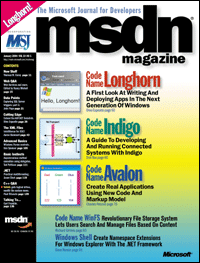

MSDN Magazine January 2004 | Microsoft Learn
source link: https://learn.microsoft.com/en-us/archive/msdn-magazine/2004/january/msdn-magazine-january-2004
Go to the source link to view the article. You can view the picture content, updated content and better typesetting reading experience. If the link is broken, please click the button below to view the snapshot at that time.

MSDN Magazine January 2004
We're no longer updating this content regularly. Check the Microsoft Product Lifecycle for information about how this product, service, technology, or API is supported.
- Article
- 10/11/2019

January 2004
Code Name Longhorn: A First Look at Writing and Deploying Apps in the Next Generation of Windows
The next version of the Microsoft Windows operating system, code-named "Longhorn," marks a significant change not only in terms of how the operating system works, but also in the way in which applications are built. The Longhorn version of Windows includes a new storage system, natural search technology, and an increased emphasis on security and trustworthy computing. Here the author provides an overview of Longhorn, focusing on the build-once, deploy n-times application model. In addition, he discusses the new language, code-named "XAML," that's used to create UI elements, then presents some working samples. Dino Esposito
Code Name Indigo: A Guide to Developing and Running Connected Systems with Indigo
This article describes a collection of new programming frameworks that are part of "Longhorn," the upcoming version of Windows. "Indigo," the code name for this framework, provides rich support for service-oriented design that is complementary to traditional object-oriented approaches. Indigo marries the best features of .NET Remoting, ASMX, and .NET Enterprise Services into a unified programming and administration model. Indigo's deep support for standard protocols, including HTTP, XML, and SOAP, makes it easier to integrate applications and services without sacrificing security or reliability. Don Box
Code Name Avalon: Create Real Apps Using New Code and Markup Model
The presentation subsystem in the next version of Windows, code-named "Longhorn," offers powerful new capabilities to developers. This subsystem, code-named "Avalon," allows developers to take advantage of its capabilities through a new markup language code-named "XAML." In addition, modern object-oriented programming languages such as C# and Visual Basic .NET can be used to tie everything together. Because most applications written to Avalon will probably be a mix of XAML and programming code, this article discusses XAML tags used to control page layout along with the procedural code written to respond to events. Charles Petzold
Code Name WinFS: Revolutionary File Storage System Lets Users Search and Manage Files Based on Content
One of the monumental problems organizations face today is aggregating information that's stored in disparate formats. Knowledge workers have long wanted to be able to search for content independent of format. The next version of the Windows operating system, code-named "Longhorn," boasts a new storage subsystem that makes that task easier. That subsystem, code-named "WinFS," allows the user to perform searches based on the metadata of the stored item, regardless of what type of file it is or which application created it. This article covers the basic architecture of WinFS and explains how to use the WinFS managed API. Richard Grimes
Windows Shell: Create Namespace Extensions for Windows Explorer with the .NET Framework
Extending the Windows shell with namespace extensions allows you to create some custom functionality for Windows Explorer. One common use is to enable Explorer to present a list of items that do not exist in one real folder, but actually reside in a number of places. The view on the folder makes it look like these items are in one place, so managing them becomes easier. This article illustrates the process of creating custom shell namespace extensions using C# and the .NET Framework. The author dispels some myths about the difficulty of writing such extensions, and shows that it is easier than it was before .NET. Along the way he outlines undocumented interfaces and describes advanced techniques for consuming them in .NET. Dave Rensin
(324 KB)
Columns
Recommend
About Joyk
Aggregate valuable and interesting links.
Joyk means Joy of geeK